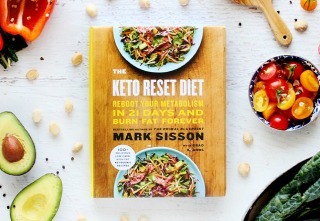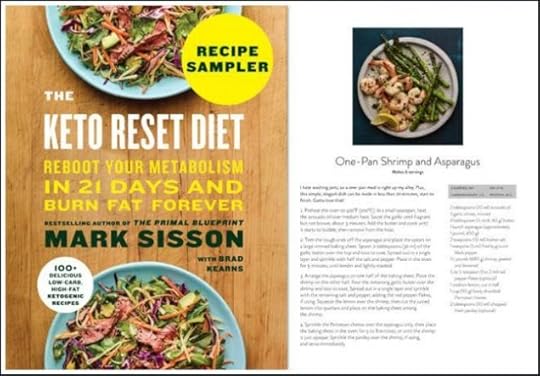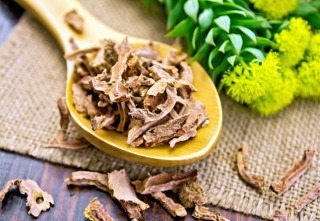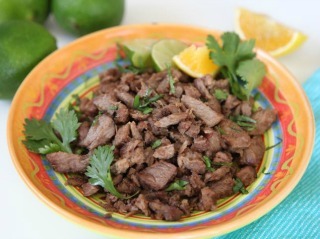Mark Sisson's Blog, page 171
August 31, 2017
How to Find Mental Strength When Dealing With Illness and Injury
 However tough, rugged, and badass we might consider ourselves, the fact is none of us is indestructible.
However tough, rugged, and badass we might consider ourselves, the fact is none of us is indestructible.
The human body, for the miracle that it is, is vulnerable as well as mortal. Even those of us in perfect health may at some point become injured—with or without the possibility of full recovery. Most of us are down for the count (or moving more slowly) a couple times a year with this or that virus. But even with the best Primal efforts, there are those among us who will go through medical crises. For all of us, age will inevitably diminish some of our faculties (although not how the culture tells us it must).
How we mentally move through these experiences will certainly have a hand in our prognoses, but more importantly it has the power to cultivate a more unconditional resilience.
The history of life itself revolves around the struggle to survive, to fend off, to recover. Remains of our prehistoric ancestors reveal their struggle with broken bones, episodic pestilence, and even (in some cases) long-term disability. Our lot has always been up against the pitfalls of physical existence. Recent generations, I think, had an easier time accepting this truth than we might.
Today we enjoy remarkable medical advancements. We know more about nutrition, fitness, and health than ever (although we’re still waiting for CW to catch up on that front). Although more of the population contends with chronic disease than ever, our perceptions of health have also undergone a curious shift that can isolate disease, injury, or even common illness.
After all, we’re supposed to be too busy, too ambitious, too invincible for a standard sick day.
In a society that jokes, “I’ll sleep when I’m dead,” and aggrandizes overworking, what does that mean for those who need to spend months if not years (or the rest of their lives) downshifting into a lifestyle that requires them to center life around self-care?
Blame it perhaps on culture and media forces that favor the shiny, happy and distracted over the complex, nuanced, and messy. Troubles aren’t fit for public display. We go away for help. Give us the inspiring comeback story, but the gritty process is best left behind the white curtain, thanks.
It’s a far cry from our ancestral imprint.
While we can and should be grateful for our sophisticated care systems, state-of-the-art facilities, and corrective treatments, they have, to some degree, resulted in disease being more marginalized and people feeling more medicalized. There are exceptions of course—developments that thoughtfully speak back to this trend, that seek to reinstate community, ritual, and even spirituality within health treatment and wellness care. Human story and connection can be profoundly healing forces on their own after all.
I see many people come to the Primal lifestyle with various kinds of illnesses, injuries and disabilities. Some have chronic conditions they’re looking to overcome through lifestyle changes. Others are more interested in a measure of relief or alternative means for enhancing their lives beyond certain personal incapacities (temporary or long-term). A Primal lifestyle has something powerful to offer for all of these intentions.
Regardless of their particular goals, however, many of these folks navigate extra emotional or mental hurdles—short-term or long-term—in moving their health and lives forward. The journey may be more nuanced and profoundly meaningful, as we all witness in MDA success stories. The Blueprint’s promise is just as solid, just as bold in these circumstances: you can make progress in a Primal lifestyle—no matter what your current medical status or physical hardship.
Chronic (but Reversible) Conditions
Whether it’s type 2 diabetes, high blood pressure, “high” cholesterol, or a digestive or autoimmune disorder, you may have been told it was a life sentence—and perhaps one that will ultimately take your life. Perhaps you’ve lived with that story, that expectation for years—even decades. Maybe with a standard American diet, reduced activity, psychological stress, or the side effects of multiple prescriptions, your symptoms have worsened over time, and it’s only appeared to confirm the initial prognosis.
But there’s plenty of reason to reclaim hope.
Many of the people in the MDA Success Stories section began their Primal endeavors with exactly the same diagnosis—and prognosis. They were told they would be on medication their entire lives. They heard that their conditions would inevitably worsen with time and perhaps even result in growing complication, illness, and incapacity. Their reality, however, ended up looking much different, thanks to their Primal efforts.
Countless readers have overcome or significantly decreased the burden of these types of conditions with the right changes. And here’s an important point… Reclaiming vitality isn’t a black or white affair. Perfect ideals shouldn’t discourage us from valuing progress.
Success doesn’t come overnight. It might take some additional care in shaping the Primal eating or fitness ideals to certain immediate needs or limitations. It’s imperative to take your time. Use your intuition and self-attunement to discern what’s a manageable step forward. Get support from those who have been through the process and those who know your story.
Talk to your doctor about your Primal changes, but know you may not get resounding encouragement if he/she thinks in conventional terms. Nonetheless, keep up on your lab testing, learn what additional markers may give you better or more precise information. Consider taking advantage of a consultation with a Primal-friendly physician or a Primal Health Coach, particularly if your condition is advanced.
Bring compassion to the beliefs you once held about your condition even as you leave them behind. All of us know and do the best we can with the information we have available to us at any given time. Make feasible but encouraging short-term goals you feel good about, and keep making them as you surpass each milestone. Actively rewrite your story through journaling, talk therapy, photo albums or other means to follow and demonstrate the efforts and achievements you never believed would be possible again.
Physical Injury, Limitation, or Chronic Pain
It’s probably safe to say that thousands of Primal adherents came to the Primal Blueprint with a history of physical limitation related to injury or disease. For some, physical limitation might be a relatively recent occurrence. For others, it’s been something they’ve lived with for years. This may go without saying, but I’ll say it anyway—because there may be issues of substantive damage, muscle imbalance, decreased flexibility or structural misalignment, get support with an appropriate medical professional, physical therapy provider, or appropriately trained coach.
Remember, even if you can’t do all of the Primal Essential Movements, you will find ways to make your current and developing abilities work for you. Be creative with substitutions and adaptations. Bringing certain exercises to the pool rather than unpaved trails may open up your program and limit strain on joints for example.
Be patient, and work with a series of short-term goals without an over-attachment to a final outcome. Work with the idea of evolving acceptance. Those who live long-term with chronic pain, for example, often share that a certain dimension of surrender relieves the psychological struggle they experience, which can free up energy for physical effort. If nothing else, you aren’t working against yourself. Frustration, especially when we direct it against ourselves, is draining.
Naturally Shifting Abilities
As I’ve written many times in the past, among the boons of a Primal lifestyle is its ability to roll back the common effects we assume are inevitable results of aging. It’s unfortunate that we accept poor health as an inescapable outcome of moving into later decades.
Many of us here offer proof that aging doesn’t have to equate with limited opportunities. Nonetheless, I think some changes are natural to experience. As I say regularly, see what feels fine and what doesn’t. Use your own instinct to target/revise exercise. If your body responds better to more recovery time, let yourself take it. If alternatives to running sprints feel more effective, do those.
You may find that you’re just choosing a slower or more mindful rhythm, and (in keeping with that) different exercises or lifestyle practices appeal that didn’t before. Perhaps you want more time between heavier exercise bouts. The next day you might feel a day’s hike through some area hills more than you used to, or you might take longer to make the same trek. You might not have the same patience for a frenetic schedule or social drama. (Personally, I consider this one of the gifts of later decade living.) You’re more selective in what you give your time and energy to.
In keeping with that, it’s critical to recognize the abilities and capacities we have now that our younger years didn’t offer. We’ve likely grown in self-attunement, in equanimity, in patience, in compassion, in gratitude. We’re more comfortable saying no to what doesn’t serve us. We’re more cognizant of the elements and practices of life that do.
Primal health isn’t about looking a certain way or meeting any given set of criteria. No matter where we’re at in physical health or capacity, the Primal lifestyle offers us a means to enhance the life we have—not to feel we fall short of an ideal.
The ancestral story reminds us that we’re meant to move and progress through life, not feel fixed in place. The Primal story is our story. It’s dynamic, fluid, fluctuating just as we are—each of us from a unique and promising space.
Thanks for stopping by today, everyone. I’d love to hear your thoughts on the comment board. Have a good end to the week.
Want to make fat loss easier?
Try the Definitive Guide for Troubleshooting Weight Loss for free here.
The post How to Find Mental Strength When Dealing With Illness and Injury appeared first on Mark's Daily Apple.



August 30, 2017
Get Ready to Reset and Go Keto! Incredible Pre-Order Bonus Offer
 As you probably already know, the ketogenic diet has become an extremely popular health trend as well as a personal passion of mine. Google data indicates that “keto” has now surpassed “paleo” as the most popular diet-related search term. Both mounting science and user experiences are validating keto as highly effective for reducing excess body fat quickly, improving cognitive function, minimizing disease risk factors, improving athletic performance, and promoting longevity. I sincerely believe that a ketogenic eating plan could represent the greatest breakthrough in the history of nutritional science—and the history of dieting (finally!)—to promote successful long-term fat loss and weight management.
As you probably already know, the ketogenic diet has become an extremely popular health trend as well as a personal passion of mine. Google data indicates that “keto” has now surpassed “paleo” as the most popular diet-related search term. Both mounting science and user experiences are validating keto as highly effective for reducing excess body fat quickly, improving cognitive function, minimizing disease risk factors, improving athletic performance, and promoting longevity. I sincerely believe that a ketogenic eating plan could represent the greatest breakthrough in the history of nutritional science—and the history of dieting (finally!)—to promote successful long-term fat loss and weight management.
Unfortunately, the booming popularity of keto has also made it the latest fad diet, replete with marketing hype, oversimplification, misinformation, and promoters misinterpreting the foundational science and proven strategies. Through my own personal keto journey and extensive consultation with the world’s most respected scientific experts, I’ve discovered that there’s a right way and a wrong way to go keto—and knowing the right way can make all the difference in the results you achieve.
I’ve been really focused on sustaining nutritional ketosis this year and monitoring my blood ketone and glucose levels in response to eating patterns. I’ve cranked out some meaty recent posts on the subject with the The Definitive Guide to Keto and Is Keto For Everyone?, among others.
My Primal Kitchen® product line is keto-friendly, many recipes in my new Primal Kitchen Cookbook contain a special icon denoting them as keto-friendly, and we have plenty of keto offerings on the menu at Primal Kitchen Restaurants. Everything is moving so fast in the keto scene!
Consequently, my writing partner, Brad Kearns, and I essentially dropped everything at the start of 2017 to do a total immersion into keto and quickly produce what we believe to be the first truly comprehensive book on the subject.
There are plenty of keto recipe books out there already, and a bunch of quick-fix keto blast offerings of the print and digital variety, but my new book, The Keto Reset Diet (that I first mentioned in the Definitive Guide to Keto post in June) delivers a complete presentation of all aspects of keto.
You’ll follow a thoughtful, proven approach that is flexible, highly customizable, effective, and intuitive instead of regimented. With The Keto Reset Diet, you’ll proceed at a sensible pace and never have to struggle, suffer, or backslide like so many ill-prepared and misinformed enthusiasts. I’m confident the book and your full embracing of a keto lifestyle will change your life!
Pre-Order Bonus Package of Digital Treasures!
With just a short time left before the book’s official release date of October 3rd, I’ve created an attractive bonus package to entice you to order the book and get started on your keto journey as soon as you finish reading this post. Just pre-order the book from your favorite retailer (online or physical store), then complete our simple online pre-order bonus form. You’ll be able to immediately download the following free gift items….
Exclusive Author Talk Show
I detail the scientific particulars of keto-adaptation, the complementary lifestyle elements necessary to succeed, the athletic performance benefits of keto, and the way you can conquer the challenge of fat reduction once and for all by going keto. My co-author, Brad Kearns, and I go deep and unplugged in this never-before-released hour-long discussion!
$10 Gift Certificate
Enjoy your shopping experience at PrimalBlueprint.com with a $10 Gift Certificate that you can use on ANY products (good for any purchase $20 or above). Check out the Primal Kitchen line of healthy salad dressings and mayonnaise—they’re 100% keto-approved and a delicious addition to many meals.

Primal Blueprint Healthy Sauces, Dressings, and Toppings eBook
Enjoy dozens of low-carb, grain-free preparations that can add variety and pizazz to your primal meat and veggie dishes. Learn about the primal-approved base ingredients, and then it’s off to the races to create your dips, rubs, dessert toppings, marinades, seasonings, salsa, pesto, flavored butter, tapenade, gravy, and much more!
The Keto Reset Diet Recipes eBook
A sneak preview of some of my favorite recipes in the book—conveniently formatted for printout and pasting on the fridge door. These delicious meals will help you realize how easy, fun, and satisfying going keto can be!

Why Consider Keto?
While enthusiasts are vigorously debating the best long-term keto strategy, or whether keto is even appropriate for certain individuals, we must acknowledge that fat- and keto-adapted was the default factory setting of our ancestors.
It’s likely that over the last 2.5 million years, most of our ancestors were in ketosis for a great portion of their lives. Consequently, we retain this hard-wired genetic predisposition to function with fat as our primary fuel source. Acknowledging this, Robb Wolf further speculates that going keto may deliver a reset effect at the genetic level, such that it can help you recover from leaky gut and autoimmune-related health conditions, metabolic damage caused by yo-yo dieting, and even exposure to environmental toxins.
There is no failure associated with keto. Any time spent pursuing keto improves metabolic flexibility and helps release you from the debilitating bonds of hunger, cravings, and frustration with reducing excess body fat.

While most primal enthusiasts have made the adjustments necessary to escape extreme carbohydrate dependency and wildly excessive insulin production, a great many poor souls still linger in the gray twilight that’s shy of being fully fat- and keto-adapted. (If you don’t know the epic Teddy Roosevelt quote I’m honoring, check it out). This perhaps results in falling a bit shy of reaching and maintaining ideal body composition long-term.
This is why I firmly believe that completing at least one complete Keto Reset journey (The initial 21-Day Metabolism Reset, fine-tuning with morning fasting, then six weeks of focused nutritional ketosis) is a bucket list item for every single one of us. Even if you decide over the long term to consume carbohydrates in a pattern that doesn’t promote nutritional ketosis, you’ll have developed an outstanding level of metabolic flexibility. This is the ability burn a variety of fuel sources, be free from dependency on regular meals, rarely be hungry or stressed about food, and be able to reduce excess body fat once and for all and not worry about it anymore—even if you take occasional departures from your typical ancestral-aligned eating patterns.
The Keto Campfire
A great way to understand how fat and ketones burn more cleanly than glucose is to use the analogy of a campfire.

A carbohydrate dependency diet is analagous to a crappy campfire built with twigs and wadded up newspaper. You produce a lot of smoke (free radicals caused by burning glucose without the protective effects of mitochondria) and have to constantly stoke the fire with quick and dirty-burning fuels (high-carbohydrate meals and snacks) to stay warm. In contrast, the keto campfire represents a state of fat- and keto-adaptation. You have taken the time to warm up your big logs (stored body fat and ketones) that will burn cleanly and for a long duration.
Speaking of building a proper campfire and becoming metabolically efficient, I want to give you some clarity on something that has recently become my pet peeve: confusing the metabolic state of ketosis (literally, accumulating ketones in the bloodstream faster than you are burning then) with being fat- and keto-adapted (adept at burning stored energy, and free from dependency on regular doses of dietary carbohydrates as your main energy source).
Details are in the book but for now, own this: Just because you’re making ketones doesn’t mean you’re adapted to burn them efficiently. Conversely, you may be producing a minimal amount of ketones (and delivering low blood values) but be highly fat- and keto-adapted so you’re able to reap the benefits of a low-carbohydrate eating pattern.
While the prevailing mindset in the keto community seems to be higher is better with blood readings, I’m feeling increasingly like good old-fashioned subjective evaluation is far more relevant than biometrics. Can you skip a meal and still function well physically and cognitively? Are your appetite, mood, and energy level stable all day long? These are the hallmarks of being a fat-burning beast. I’m preparing an entire follow-up post on these concepts, so stay tuned!
Let’s Go Keto!
I am hopeful that you’ll join me on this journey to fat- and keto-adaptation by ordering a copy of your book today and getting the killer bonus package. Of course I celebrate selling more books, but of deeper significance is the truth that a huge portion of the population is still adhering to conventional wisdom recommendations that we primal folks acknowledge to be harmful and unsupported by real science. This leaves many unknowingly trapped in carbohydrate dependency and lifelong insidious weight gain despite careful attention to diet and exercise.
For example, I recently encountered a bestselling author in the health and diet realm who had never heard of ketones! Yes, we are fighting a battle, and we need all hands on deck to spread the word. I want this revolution that started in 2006 at MarksDailyApple to continue to grow and impact more people, and keto represents the highest expression of the benefits of ancestral eating.
I imagine many of you might have a lot to say about keto already, and I look forward to checking out all of your comments from this post. Also, be sure to head over to Facebook and sign up for our burgeoning Keto Reset discussion group. Just submit a request to be added. We’ll keep the dialog going!
The post Get Ready to Reset and Go Keto! Incredible Pre-Order Bonus Offer appeared first on Mark's Daily Apple.



August 29, 2017
Two Final (and Favorite) Adaptogens: Rhodiola Rosea and Bacopa Monnieri
 I’ve taken up the subject of adaptogens over the last several weeks, and today I’m wrapping it up with two of my favorites: Rhodiola rosea and Bacopa monnieri.
I’ve taken up the subject of adaptogens over the last several weeks, and today I’m wrapping it up with two of my favorites: Rhodiola rosea and Bacopa monnieri.
Primal aficionados from way back will know that I’m a big fan of Rhodiola rosea. It’s an integral component of one of the original Primal Blueprint supplements, Primal Calm. It’s a formula I put together for my own needs and eventually decided to offer in the supplement line. (That seems to be how I come up with things, I suppose….) I’ve written in the past about stress being one of the issues I’m still working on in my Primal life, and adaptogens have been a useful tool I’ve employed. Living with an ancestral template doesn’t preclude being scientifically resourceful.
But let’s dig into these final two players….
The Details on This Duo
Throughout my adaptogenic posts, I’ve made a point of dwelling briefly on the key elements and life cycle of each herb. Personally, I’m always hesitant using (or, indeed, recommending an herb or supplement that I’m not intimately familiar with. Knowing the ins and outs of the herb itself helps you know how to source the good stuff and how to minimize the footprint of that supplement wherever possible.
Rhodiola Rosea
No doubt reflecting its rich history of therapeutic use, Rhodiola rosea (rhodiola) goes by many names, including golden root and Arctic root. A perennial plant with red, pink or yellow flowers, rhodiola likes the barren tundra of northern latitudes and high altitudes best. It’s these kind of extreme growing conditions that seem to make a lot of adaptogens just so darn potent.
While Rhodiola Rosea is now grown in many of the colder parts of the world, including Canada, Alaska and Greenland, not all Rhodiola is created equal. This hardy herb is native to Siberia, and it appears that this is where it may traditionally have attained the highest concentration of therapeutic active ingredients. These healing ingredients are numerous and include an estimated 140 compounds isolated from both the roots and rhizome of the plant.
Bacopa Monnieri
As with many of the adaptogens I’ve already covered, Bacopa monnieri (bacopa) has been in therapeutic circulation in Ayurvedic circles for centuries. More recently, Western soothsayers have caught on to bacopa’s abilities as a powerful nootropic and analgesic.
Bacopa’s favorite haunts are a far cry from the windswept barrens of the north, instead preferring to grow in the wetlands of subtropical locales across the world. It’s a perennial, creeping herb that grows vigorously in a range of aquatic biomes, making it a popular aquarium plant.
Because bacopa is now native to much of the world’s wetlands, sourcing high quality extracts and supplements of the stuff isn’t going to be overly difficult. Bacopa is loaded with bacosides, the active chemical compounds that enable its adaptogenic impacts. I also find it a nice coincidence that spell check tries to turn it into “bacon” each time, but that’s a Primal mind for you.
The Science on Rhodiola Rosea and Bacopa Monnieri
While there’s no shortage of research surrounding these two adaptogens, it’s worthwhile approaching any findings with a grain of salt. As with many emerging (in Western spheres, at least) subjects of interest in the literature, it often takes some time before a sufficiently broad spectrum of data is available to make any lasting assumptions about their efficacy. That being said, a lot of the preliminary research is very promising indeed.
Rhodiola Rosea
Arguably, rhodiola’s greatest claim to fame is its ability to alleviate stress (unsurprising, given its status as an adaptogen) and elevate mood via complex pathways that act on central biogenic amines and beta-endorphins. This, along with rhodiola’s neuroprotective, nootropic and antidepressive effects, is precisely why it’s an integral component in my Primal Calm formula.
But the rhodiola research is something of a minefield, riddled with studies confounded by small sample sizes, lack of placebo controls, and sometimes insignificant differences between treatment and control groups. That being said, most of the research is overwhelmingly in favor of rhodiola as a powerful therapeutic herb. This is one I have the most experience with, and I can say firsthand how the vast majority of these benefits have played out for me and others. That said, I’m all for more research on the matter.
Here’s the quick and dirty on what’s been unearthed so far.
Mental Health and Mood
A 2015 study published in the Journal of Phytotherapy Research sought to determine the impact of rhodiola on self-reported anxiety, stress, cognition, and a host of other mental parameters. Eighty subjects were divided into either a twice-daily commercial formula (containing 200 mg rhodiola) group or a control group. Compared to the controls, the rhodiola group showed notable improvements in mood and significant reductions in anxiety, stress, anger, confusion and depression after 14 days.
While the study presents a nice foray into the potential of rhodiola for treating any number of mental maladies, it’s important to note that supplements like the one used in the study are often loaded with nasty fillers. Why they feel the need to put titanium dioxide and several other strange ingredients is beyond me. Also worth noting is the short duration of the study and the fact that it wasn’t placebo controlled, but the study proponents seemed to think the results were still significant.
Getting down to specifics, there’s a fair amount of debate on whether rhodiola can provide a decent treatment for depression. Studies in mice indicate that injection of salidroside, one of rhodiola’s more notable active ingredients, can exert a strong antidepressant effect along with alleviating anxiety and enhancing fear memory. A small 12-week trial examining the effect of rhodiola on humans, on the other hand, suggested that the adaptogen was less effective than sertraline (the generic version of Zoloft) in treating major depressive disorder. Perhaps if the participants had been given a stronger dose or an extract higher in salidroside, however, the results would have been more favorable. (For those of you who have applied Primal Calm toward depression therapy, I’d be interested in hearing your experience on this.)
Physical and Mental Fatigue
Rumor has it that rhodiola may be a useful adaptogen to have on hand for times of both physical and mental fatigue. And what better people to test this hypothesis on than nursing students doing shift work? A 2014 study examined the effect of 364 mg rhodiola at the beginning of the student’s shift and again within the following four hours of shift work over a 42 day period. Somewhat surprisingly, the proponents found that rhodiola, compared with the placebo, actually worsened fatigue, mysteriously noting that the results should be interpreted with caution. Perhaps by alleviating the stress those students were under the rhodiola allowed them to relax and gain a heightened awareness of their levels of fatigue? One can only speculate. I’ve never made a point of using it for this kind of purpose, so I can’t speak to the point personally. Again, perhaps others of you can.
However, another study performed a meta-analysis of over 206 articles relating to rhodiola, with 11 of those specific to physical and mental fatigue. Two of six trials examining physical fatigue in healthy subjects found rhodiola to be effective, as did three out of five studies investigating its impact on mental fatigue. Not overwhelming odds, but there’s enough to suggest a connection and stimulate further research.
Exercise Performance and Recovery
While the research on rhodiola and physical fatigue is a trifle disappointing, findings relating to the effect of rhodiola on endurance and exercise performance are anything but.
A 2003 study examined the effects of oral rhodiola supplementation on exhaustive swimming in rats. Impressively, 50 mg/kg rhodiola extract was able to prolong the duration of exhaustive swimming by a substantive 25%, both in comparison with Rhodiola crenulata extract and controls. The R. rosea extract also activated synthesis of ATP in skeletal muscle mitochondria and encouraged faster recovery after intensive exercise.
Two small studies on humans have produced similarly promising results. A 4-week trial on 14 trained male athletes showed that rhodiola supplementation reduced lactate concentrations along with lowering certain markers of skeletal muscle damage during exhaustive exercise.
A slightly larger study compared rhodiola supplementation (200 mg rhodiola plus 500 mg starch) to a placebo of straight starch. Over the course of several different trials involving limb movement speed, aural and visual reaction time, knee extensions and endurance exercise, researchers found that rhodiola intake significantly increased time to exhaustion and elevated pulmonary ventilation during exercise. The take-away? “Acute Rhodiola rosea intake can improve endurance exercise capacity in young healthy volunteers.” This purpose, along with mitigating mental stress, has been closer to my personal use of the adaptogen.
Bacopa Monnieri
Memory and Cognition
Bacopa earned its hallowed status in the Ayurvedic world largely on its purported ability to improve memory and elevate cognitive function. If three centuries of anecdotal evidence is anything to go by, bacopa (aka brahmi) is a nootropic force to be reckoned with. But what does science say about the matter?
As usual, the jury is still out on this one. A 2002 study tested the effects of bacopa on various memory functions in 76 participants ages 40 and 65. Aside from a reported improvement in new information retention, other memory variables were unaffected by long-term bacopa supplementation.
At the other end of the spectrum, a similar study with a larger group of older Australians found that bacopa supplementation over the course of three months significantly improved verbal learning, memory acquisition, and delayed recalls. Given that this was a larger, more recent study, I’m more inclined to give credence to the results of this study, but clearly there’s a need for more research on the topic.
In the cognition arena, things are a little less contested. A 2014 meta-analysis that included 437 subjects across 9 studies indicated that bacopa can improve cognition and decrease choice reaction time. That could be all the edge you need to win your favorite gameshow.
Finally, another meta-analysis published in 2016, found that across five studies bacopa demonstrated significant improvements in language behavior and a number of memory sub-domains.
Pain
Beyond clarity of mind, bacopa shows a decent amount of potential in the analgesic arena. A 2013 literature review noted that “Bacopa monnieri, a renowned ayurvedic medicine has a strong antidepressant effect and significant antinociceptive effect, which is comparable to the effect of morphine via adenosinergic, opioidergic, and adrenergic mechanisms. BM has been also reported to be effective in neuropathic pains.”
This could make bacopa an effective augmentation to conventional morphine pain relief for certain applications (a pain specialist would be able to speak to specific conditions more than I can here), with the added benefit that it appears to alleviate some of the side effects associated with chronic opiate use. For those who live with chronic pain and depend on conventional pain meds (especially opiates) even after healthy lifestyle adjustments, it might be worth a talk with your doctor.
Drilling down into the specific studies, the findings appear no less promising. A paper that examined the effect of bacopa extract on neuropathic pain found that it increased pain thresholds and reduced hyper-sensitivity. Other tests on animals echo these findings, with bacopa providing an opioid-type pain relief without the withdrawal symptoms associated with the likes or morphine.
Neurodegeneration
Given bacopa’s role as a nootropic, it’s not overly surprising to discover that it may also be an effective natural treatment for neurodegenerative diseases. A 2013 study that compared the neuroprotective abilities of bacopa to donepezil, a common prescription treatment for Alzheimer’s, found that bacopa was at least as capable as the pharmaceutical in many respects, making it a potentially powerful drug in the treatment of certain neurodegenerative diseases.
Another study published this year showed that bacopa administration “was seen to protect the cholinergic neurons and reduce anticholinesterase activity comparable to donepezil, rivastigmine, and galantamine.” Researchers found that bacopa promoted free radical scavenging and helped to protect cells in the prefrontal cortex, hippocampus, and other areas of the brain.
What Are the Contraindications?
Over the course of these adaptogenic articles, I’ve had a hard time tracking down anything overly damning in terms of side effects or contraindications. There’s a reason for that: adaptogens are generalists by nature, alleviating stress throughout the body—but in so doing bypassing many of the side effects associated with condition-specific drugs and treatments.
With that said, there are times when you should use these herbs carefully or not at all. And, the usual disclaimer—consult your physician before beginning any new supplement regimen (but you know this already). Here’s a quick look at dosage effects and complications associated with rhodiola and bacopa.
Rhodiola Rosea
Lab tests indicate that reaching toxicity levels from rhodiola supplementation would be very difficult indeed, with a 70kg man needing around 235,000 mg rhodiola to knock himself flat. Given typical doses range between 200 and 600 mg per day, it’s fair to say that you needn’t worry overmuch.
As far as side effects go, it’s a slippery slope. Keep in mind that individual reactions vary. Based on anecdotal hearsay, small doses of rhodiola can produce energizing effects while large doses may send you in the other direction, making one relaxed or drowsy. The reason behind this may be due to the opioid-type effect rhodiola exerts on the brain, elevating mood and concentration and even increasing caffeine metabolism.
This in turn can make people who are anxious or high-strung feel jittery or overstimulated, particularly if they’ve made the mistake of also knocking back a cup of coffee that morning. The drowsy effects may come about due to the depletion of those same neurotransmitters, caused by overdosing on rhodiola and hence overloading the receptors.
As such, those who consume a lot of caffeine or suffer from bipolar disorder should probably steer clear of rhodiola.
I also make a point of saying pregnant or nursing women should avoid adaptogens.
Bacopa Monnieri
Bacopa side effects are slightly more straightforward: mild nausea, upset stomach and diarrhea are uncommon but possible—probably if you’re taking too high a dose or too frequently. Studies in rats have indicated that bacopa supplementation at high doses can result in lowered fertility, but whether this applies to humans or not is anyone’s guess.
It’s important to note that bacopa is contraindicated if you’re taking thyroid medications, antidepressants, or sedatives. And, again, avoid if you’re pregnant or nursing.
What to Look for in a Supplement
As always, choosing quality over quantity is always a wise move when you’re in the market for adaptogens. Find out where the adaptogen in question grows best, what active ingredients it should contain in sufficient concentrations, and how it’s been processed and packaged.
For rhodiola supplements, seek out products that contain 2 to 3% rosavin and at least 0.8% salidrosides. (This generally reflects the formula used in scientific trials.) A lower dosage of well-sourced, potent rhodiola can work for most people (100 mgs does it for me), but if you have particular needs that suggest a higher dosage might be better, increase slowly with a maximum of 400 mg/day if it sits well with you. As always,
Similar advice applies to bacopa, however the origin doesn’t matter quite as much. Try to source organic bacopa supplements where possible, and only buy those that are packaged in light-resistant containers. It seems 300 mg/day appears to be the “sweet spot” for bacopa supplementation, but once again play it safe and start with a low dosage and work your way up. Everyone’s tolerance is different. Less can be more.
This wraps up my foray into adaptogens for a while. Thanks for stopping by today. Let me know if you have follow-up questions or other adaptogens you’d like to see covered down the road. Take care.
The post Two Final (and Favorite) Adaptogens: Rhodiola Rosea and Bacopa Monnieri appeared first on Mark's Daily Apple.



August 28, 2017
Dear Mark: Grok’s Terrible Genes; Fasting, Starvation, and Metabolism
 For today’s edition of Dear Mark, I’m answering two questions from readers. The first one concerns a study I linked to in this week’s Weekend Link Love. It appears to suggest that ancient humans had worse genes than modern humans have, that they were at greater risk for many different disorders and diseases. How can this be? Last but not least, Pierre expresses skepticism at the notion of fasting or starvation causing metabolic slowdowns. I agree, but only to a point, and I explain why.
For today’s edition of Dear Mark, I’m answering two questions from readers. The first one concerns a study I linked to in this week’s Weekend Link Love. It appears to suggest that ancient humans had worse genes than modern humans have, that they were at greater risk for many different disorders and diseases. How can this be? Last but not least, Pierre expresses skepticism at the notion of fasting or starvation causing metabolic slowdowns. I agree, but only to a point, and I explain why.
Let’s go:
Mark, what’s your take on the ancient human gene study you mentioned in weekend link love today? This one: http://digitalcommons.wayne.edu/humbi...
I found it really interesting.
Jared
The paper has a lot going on.
First, we find that the genetic disease load has not been increasing in modern humans. Many have proposed the opposite: That the rise of modern medicine and technology has relaxed the selective pressures of everyday living and allowed genetically “unfit” people to survive and reproduce, thereby increasing the rate of deleterious mutations. This paper seems to contradict that.
We find that the genetic load in certain disease categories was higher in ancient humans. Looking at individual samples, we find that the Altai Neaderthal and Otzk the Iceman had some issues. The Neanderthal had a higher genetic risk for neurological disease, immune issues, cancers, gut disorders, and metabolic disorders. The Iceman had a higher genetic risk for cardiovascular, immune, gut, and metabolic disorders.
There are several ways to interpret the results. The most common interpretation will probably be that the genetic disease load was greater in ancient humans because they weren’t living long enough for the diseases to take root and impact reproductive fitness. I think that’s part of it, but my take is different.
Maybe ancient humans carry more genes that in modern environments increase risk of diseases, but in ancestral environments were neutral or even increased fitness. Heart disease wasn’t an issue because he wasn’t chowing down on packaged cupcakes, Panda Express, and Pepsi.
If you transported Otzi the Iceman or the Altai Neanderthal to the present day, set them up with an apartment on the Las Vegas Strip with neon signs blaring into their room at all hours of the night and ensured they spent their days hanging out at the slots and pigging out on the buffets, they’d be fat, diabetic, and feeble more quickly than most modern humans in the same position.
This is why traditional people get hit so hard by modernity. It’s perhaps why the Pacific Island nations are among the fattest in the world. It’s why native peoples all over the world, when influenced by industrial food cultures and modern sedentary lifestyles, tend to be fatter and sicker than the broader population of their countries, whether it’s Canada, the US, or Australia.
Consider the genetic predisposition to alcoholism. It’s far higher in American Indians than Americans of European descent due to a lack of protective genetic factors and higher incidence of deleterious genetic factors (and, of course, environmental factors). If you dug up some American Indian graves from the 1400s and ran DNA tests on the remains, they’d show up as having a high risk of alcohol dependence. But back then, when they weren’t exposed to alcohol, those “deleterious” genes weren’t actually deleterious.
I suspect the same thing applies to the Neanderthal and Otzi. They had the genes for cardiovascular disease and irritable bowel syndrome. Media headlines say “Otzi had heart disease.” I’d say “Otzi had the genetic predisposition that increases heart disease risk in modern people living in modern environments.”
What’s really fun to think about is if these “deleterious” genetic variants offered protective or beneficial effects in other areas. What do you think?
Next, Pierre comments:
Not sure about the statement that metabolism slows down when you are starving. That doesn’t really square with my fasting results and it doesn’t make sense from an evolutionary standpoint. Seems that slowing down when you need to chase down some food would lead to your extinction.
I agree with your thinking. Fasting as most people practice it does not slow the metabolic rate. It takes at least 3 days of pure fasting for minor slowdowns to the metabolic rate to occur. Some studies even find that short-term fasting (48 hours) boosts metabolic rate by almost 4%. Others find similar results. This jibes with your results and hypothesis—”slowing down when you need to chase down some food would lead to your extinction.” It seems you’ve got about 3 days of full (or even extra) energy to acquire food before energy starts dropping. That should be plenty.
At some point, though, things break down. It doesn’t make sense from an evolutionary standpoint for humans to die when a European cave bear eats their face, since that leads to the human’s extinction, but die they do. There’s only so much the body can handle. Evolution can’t contend with a giant bear mouth chomping down on your head, nor can it contend well with a lack of food for six days straight. You just run out of juice.
That’s it for today, folks. Thanks for reading. Take care, and be sure to add your own comments, questions, and answers down below!
The post Dear Mark: Grok’s Terrible Genes; Fasting, Starvation, and Metabolism appeared first on Mark's Daily Apple.



August 27, 2017
Weekend Link Love – Edition 466
 Research of the Week
Research of the WeekJust having your phone in the same room drains your cognitive capacity, even if it’s turned off.
99% of your gut bacteria are a complete mystery.
Belly fat increases cancer risk.
Researchers used Twitter to discover the geography of happiness.
New Primal Blueprint Podcasts
Episode 183: Elizabeth Baldwin-Lodge: Host Elle Russ chats with Elizabeth Baldwin-Lodge, an author who found her calling after two failed celebrity marriages were unable to fill the void in her life. Despite having “everything,” she was only able to be truly happy when she figured out how to be happy within.
Each week, select Mark’s Daily Apple blog posts are prepared as Primal Blueprint Podcasts. Need to catch up on reading, but don’t have the time? Prefer to listen to articles while on the go? Check out the new blog post podcasts below, and subscribe to the Primal Blueprint Podcast here so you never miss an episode.
Interesting Blog Posts
Why omega-6 seed oils may be the primary cause of the diseases of civilization.
How weighted blankets could help with stress and anxiety.
Media, Schmedia
Tressa’s inspiring success story.
High-dose B12 supplementation when you don’t really need it may raise the risk of lung cancer.
“I don’t trust people to take so much control over the future of human nature.” Me neither.
Everything Else
“Whole Paycheck” might stop making sense.
Babylonians did trigonometry. Well, some of them.
Why vertical farms probably won’t work like proponents think they will.
All’s clear for the decisive trial in MDMA for PTSD patients.
As the prospect of human embryo genetic engineering draws closer to reality, some Chinese parents are asking for alterations to alcohol processing genes that would allow social drinking for business purposes.
Things I’m Up to and Interested In
The kind of addiction I can get behind: To learning.
Study that made me go “Hmm”: Humans from the ancient past had a higher load of genomic disease risk than humans from today.
Article I’m pondering: “The day I found out my life was hanging by a thread.”
Kickstarter for awesome cooking equipment I’m excited about (and you should be too): Dr. Michael Eades’ SousVide Supreme Touch+.
Video I think you’ll dig: What Primal Health Coaches love about the course.
Recipe Corner
Breakfast fried rice (with cauliflower).
South African hodgepodge stew, with real grass-fed hodgepodge if you can get it.
Time Capsule
One year ago (Aug 27– Sep 2)
10 Primal-Friendly Tips from Wise People Throughout History – They really were wise, weren’t they?
The Genetics of Obesity: Are You Destined to be Fat? – No, but it might make it harder to avoid.
Comment of the Week
“Thanks for opening up some seriously sexy pillow talk: Hey, baby, let’s clear out some deleterious mutations.”
– Whoa, this is a family-friendly blog, KidPsych.

The post Weekend Link Love – Edition 466 appeared first on Mark's Daily Apple.



August 26, 2017
Lamb Carnitas
 Carnitas are usually made from pork that’s slow-cooked in lard until the meat melts down into tender little morsels. Those little morsels are then fried until crispy around the edges. Pork carnitas is delicious, there’s no doubt about it. This version of carnitas is delicious too, although quite different from the classic recipe.
Carnitas are usually made from pork that’s slow-cooked in lard until the meat melts down into tender little morsels. Those little morsels are then fried until crispy around the edges. Pork carnitas is delicious, there’s no doubt about it. This version of carnitas is delicious too, although quite different from the classic recipe.
Instead of pork, lamb is subbed in. Lamb carnitas can be served in Primal tortillas or heaped in a bowl with cilantro, shredded cabbage, avocado, sour cream, and hot sauce. This is a flavorful departure from traditional lamb dishes and provides a delicious new way to ingest all the amazing nutrients lamb has to offer, like 8 essential amino acids, several B vitamins, niacin, zinc, iron and conjugated linoleic acid (CLA).
Instead of lard, the lamb shoulder is simply braised in water that’s flavored with orange, garlic, onion, cinnamon, cumin, and coriander. When the meat is tender, fry it up quickly in a skillet, and lamb carnitas is served.
Servings: 6
Time in the Kitchen: 2 to 3 hours to braise, plus 30 minutes hands-on cooking
Ingredients

2 to 3 pounds boneless lamb shoulder, cut into 2-inch cubes (900g to 1.5 kg)
6 garlic cloves, roughly chopped
1 onion, roughly chopped
Juice and zest from 1 small orange (use a vegetable peeler or paring knife to remove strips of orange peel, avoiding the white pith)
2 teaspoons ground coriander (10 ml)
1 teaspoon ground cumin (5 ml)
1 cinnamon stick
1 ½ teaspoon kosher salt (7.5 ml)
Lard, tallow or coconut oil for frying
Instructions

Preheat oven to 300º F/150º C.
Place the chunks of lamb in a Dutch oven or wide ovenproof skillet with a lid.
Add enough water to cover the meat by 1 or 2 inches (25mm to 50 mm). Bring to a boil then reduce to a simmer. Use a ladle or spoon to skim off the white that rises to the surface.
Add garlic, onion, orange juice and zest, coriander, cumin, cinnamon stick and salt.
Cover with a lid and cook in the oven for 2 to 3 hours, until the meat is soft and tender. Check occasionally, turning the meat and adding more hot water if needed to keep the meat just barely covered with water.
When the meat is tender, remove it from the pot. Shred or slice the meat into tiny pieces. Taste the lamb, and season with salt if needed.
Heat a wide skillet over high heat with a tablespoon or two of lard, tallow or coconut oil, so there’s a very thin layer of oil in the skillet. In batches, add lamb to the skillet, frying just until crispy around the edges.
Lamb carnitas can be served with wedges of lime, cilantro, shredded cabbage, avocado, sour cream and hot sauce. Serve in a bowl, or, with tortillas – sneak in a corn tortilla, make Primal tortillas, or make cassava flour tortillas.

Want more Primal recipes?
Try the Primal Blueprint Slow Cooker Cookbook for free here.
The post Lamb Carnitas appeared first on Mark's Daily Apple.



August 25, 2017
Finding Balance After A Lifelong Eating Disorder
It’s Friday, everyone! And that means another Primal Blueprint Real Life Story from a Mark’s Daily Apple reader. If you have your own success story and would like to share it with me and the Mark’s Daily Apple community please contact me here. I’ll continue to publish these each Friday as long as they keep coming in. Thank you for reading!
 I clearly remember my first experience with binge eating. I was only about ten years old, but my home life was in chaos. My dad had recently lost his business and declared bankruptcy, and we had to sell our home and almost all of our belongings. The turmoil was hard for my parents, but was absolutely traumatic for my younger sister and me. I remember waking up during the night and hearing them fighting over the situation. My sister and I were too young to understand the details, but old enough to know it was really, really bad.
I clearly remember my first experience with binge eating. I was only about ten years old, but my home life was in chaos. My dad had recently lost his business and declared bankruptcy, and we had to sell our home and almost all of our belongings. The turmoil was hard for my parents, but was absolutely traumatic for my younger sister and me. I remember waking up during the night and hearing them fighting over the situation. My sister and I were too young to understand the details, but old enough to know it was really, really bad.
At some point during that very rough time, I bought a bag of candy. This was an unusual occurrence for me because for most of my early life I was not allowed to eat sugary foods, and especially not candy. Once I had that bag of candy in my possession, though, I was obsessed. On that same day, within the course of an hour and with nobody watching me, I ate every last piece. For that brief time, I felt safe and happy. A drive in my brain was turned on that I had never experienced before. I had to eat it all and right now.
Not surprisingly, eating all that sugar in one sitting made me sick. I had a terrible stomach ache that lasted the rest of the day. I knew exactly what had caused it, but that didn’t deter me from wanting more. As soon as I found a way to get access to candy again, I followed the same patterns of sneaking it into my room and settling in for a binge that provided comfort for a fleeting amount of time.
Sadly, I battled binge-eating disorder for about the next two decades. Whenever things evened out in my life, it was a habit that faded into the distance. But, in times of increased family stress or other life events involving change or stress, I turned to binging as my source of comfort. At that time, I didn’t know that my problem had a name, but I was ashamed of the habit and never spoke to anyone about it.
Candy and sugar were always my choice of poison, and my health suffered as a consequence. As I moved from childhood to adolescence, my hormones were unbalanced and I developed signs of polycystic ovarian syndrome (PCOS) in my early teenage years. I never had a normal menstrual cycle and I experienced depression, problems with weight management, and acne.
 Later, once I was in college, I started hormonal birth control. While the pill helped control the symptoms of PCOS, starting this prescription medication also initiated migraines that later became a chronic problem. My eating habits were still terrible, and that was the age when “fat-free” processed junk was marketed as health food, so my diet consisted of skim milk and sugar cereal, salads with fat-free dressing, a baked potato with fat-free cottage cheese, and giant bowls of fat-free chocolate ice cream.
Later, once I was in college, I started hormonal birth control. While the pill helped control the symptoms of PCOS, starting this prescription medication also initiated migraines that later became a chronic problem. My eating habits were still terrible, and that was the age when “fat-free” processed junk was marketed as health food, so my diet consisted of skim milk and sugar cereal, salads with fat-free dressing, a baked potato with fat-free cottage cheese, and giant bowls of fat-free chocolate ice cream.
As my health problems started to add up throughout my 20s, I finally started to make the connections between food and health once I hit my early 30s. The final straw when I realized things had to change was when my family physician suggested I try a daily prescription medication originally created to treat seizures to see if it would help my migraines. I was horrified that this was my fate, and at such a relatively young age. I was also diagnosed with Hashimoto’s thyroiditis, an autoimmune thyroid condition, along with multiple thyroid nodules.
There were further challenges ahead. Around 2010, I discovered veganism and thought that a 100% plant-based diet was the answer to all my problems. This strict approach that excluded all animal products seemed to work well at first. I lost weight and was feeling energetic with no migraines. I built a business creating recipes for the healthy, vegan community.
My thyroid disease took a serious turn in 2012 when I was diagnosed with thyroid cancer. I had surgery to remove the tumor, but had a very hard time adjusting to life without a thyroid gland. I started experiencing symptoms including chronic skin hives, fatigue, depression, and increased food sensitivities. I also became overly vigilant about my food choices and developed a type of eating disorder known as orthorexia. My binge habits returned after several years of remission. I realized the vegan diet was no longer serving my needs.
I wrote a blog post in June of 2014, where I shared with my readers that I was expanding my diet outside of a strict plant-based approach. It took a lot of soul-searching to get myself in the right mental space to admit that I could no longer identify as a vegan. It was a very rough transition that essentially had me starting from scratch in building my identity, community, and business.
 A friend had referred me to Mark’s Daily Apple around this time, and I also got a copy of The Primal Blueprint. So much of what Mark wrote made common sense to me, especially the comparison of Grok to his modern counterpart. It became clear to me that Mark’s work is more inclusive than exclusive, acknowledging that everyone’s needs are different and updating the primal definition as the community and body of evidence around nutritional science evolves.
A friend had referred me to Mark’s Daily Apple around this time, and I also got a copy of The Primal Blueprint. So much of what Mark wrote made common sense to me, especially the comparison of Grok to his modern counterpart. It became clear to me that Mark’s work is more inclusive than exclusive, acknowledging that everyone’s needs are different and updating the primal definition as the community and body of evidence around nutritional science evolves.
In just the last 2 years of so, I began working with functional medicine physicians and practitioners who helped me develop a plan to address the root causes of my health problems and figure out the foods that would nourish and sustain me. I also consulted an eating disorders specialist to address some of the unhealthy beliefs I had around food.
Now, fast forward to 2017, I feel like a primal “clean eating” approach is the best description of a flexible, real food way I choose to eat. I enjoy an abundance of colorful, nutrient-rich foods that I find support my health and are absolutely delicious. As a result, my overall inflammation has decreased tremendously and my health issues are much more manageable. The crazy blood sugar swings I used to experience without a balanced approach to my nutrition are 100% gone and I feel satisfied and wonderfully nourished after eating this way. My hormones have restored and balanced out naturally, and I rarely experience bouts of depression or the desire to binge-eat anymore. In fact, I can’t remember the last time I had that urge – it has been at least 3 years.
Finally, I learned my lesson that my ideal diet is much less about perfection or following a strict plan, but doing my best each day to eat foods that nourish and satisfy me. I’m so grateful to Mark and his team for all the education, recipes, produces, and resources that support the primal way of living in the modern world. I am so excited for the Primal Kitchen restaurants! I continue to share gluten- and dairy-free recipes, plus updates on my health journey on my blog, so please visit me there and keep in touch.
Carrie Forrest, MPH in Nutrition
Clean Eating Kitchen

Want to make fat loss easier?
Try the Definitive Guide for Troubleshooting Weight Loss for free here.
The post Finding Balance After A Lifelong Eating Disorder appeared first on Mark's Daily Apple.



August 24, 2017
CrossFit Training: How Primal Enables Elite Performance
 By now, you know that CrossFit and Primal are totally compatible. You can get enough carbs, calories, and micronutrients eating this way. The specific foods we recommend support healthy recovery, injury prevention, tissue health, ample energy reserves, and even longevity. The lifestyle recommendations—the Primal Laws—provide extra advantages most “diets” completely ignore. And the focus on fat-adaptation buttresses an energy system many athletes lack. All in all, Primal is a great choice for any CrossFitter.
By now, you know that CrossFit and Primal are totally compatible. You can get enough carbs, calories, and micronutrients eating this way. The specific foods we recommend support healthy recovery, injury prevention, tissue health, ample energy reserves, and even longevity. The lifestyle recommendations—the Primal Laws—provide extra advantages most “diets” completely ignore. And the focus on fat-adaptation buttresses an energy system many athletes lack. All in all, Primal is a great choice for any CrossFitter.
But one final question remains: Can it support and enable elite performance?
Most of my previous posts in the series answer this question, at least partly.
We now know that there’s nothing stopping someone from eating enough calories and carbs on Primal to support CrossFit training. It may be a bit easier to obtain carbs and calories from a pint of ice cream and garlic bread than from a big baked potato and fried plantain—but not by much. And we’re all adults here. We should be able to eat the healthy whole foods without complaining.
We know that the specific foods and lifestyle interventions Primal recommends can help athletes gain strength and build muscle, thereby improving a major determinant of a CrossFitter’s success.
We know that good sleep hygiene and circadian alignment improve recovery. We know that tamping down excessive stress and inflammation allows a healthy response to training-related stress and inflammation. if you don’t recover, you don’t perform.
We know that the macros are important, which is why many CrossFitters focus entirely on the macros, but that misses a major aspect of Primal performance benefits: the micronutrients. What’s great is that alongside all those Primal whole food carbs, protein, and calories you get actual micronutrients that make your body run better.
I’m a big picture guy. I designed the Primal Blueprint to be a simple path to better health, something that Grandma and Grandpa could figure out without having to subscribe to an RSS feed or learn how to read a PubMed abstract. Something you could explain on an elevator ride.
But I also like the weeds, the nitty gritty details, the nerdy stuff. So do many of my readers. They aren’t exactly necessary for basic good health, body composition, and fitness, but they do provide an edge to people who want to really excel. Especially CrossFit athletes.
At the top, the little things really matter. Tia Toomey won the the title of Fittest on Earth literally by a hair. In the last workout to determine the winner she was beaten by her countrywoman Kara Webb. But Tia took the title because she was more consistent and performed just THAT much better over the entire Games. Then you’ve got Matt Fraser who completely ran away with the title yet again. He is so far superior because he doesn’t compromise and takes no chances. He eats paleo. These elite athletes don’t take any chances with their nutrition. They understand that macros are only part of the story. The athlete that stops there is destined to limit his or her potential.
You’ve got to get into the weeds like Fraser and Toomey did, and I’ve got three areas that most CrossFitters completely miss if they take an “if it fits my macros” approach:
Omega-6 Intake
As CrossFitters purportedly engaged in physically-demanding activity on a regular basis, you have more protection against excess omega-6 than most. You’re burning more than you’re storing. But you’re still incorporating all those omega-6 fatty acids into your cellular and mitochondrial membranes. The mitochondria are especially critical for a CrossFit athlete because they’re the power plants of our cells, turning incoming calories into the ATP that makes squatting, running, jumping, throwing, and moving one’s body through space and time possible. Mitochondria with too much linoleic acid (the primary omega-6 fat in the food system) are bad, leaky, oxidative stress-prone power plants.
Mitochondria whose membranes contain high levels of PUFAs are less stable, more prone to oxidative damage, and function worse than mitochondria whose membranes contain more monounsaturated and saturated fats.
To avoid excessive omega-6 intake, watch out for foods that contain or are cooked in processed seed oils like soybean oil, canola oil, sunflower/safflower oil, or grapeseed oil. Whole foods sources of omega-6, like nuts and seeds, usually don’t cause problems as long as you avoid the processed, refined, concentrated oils.
Prebiotics
Fiber is fiber, in most people’s minds. It “provides colonic bulk.” It “absorbs cholesterol.” It enables bowl-shattering bowel movements. It’s “good,” for some reason. For many years, I’ve talked about the importance of the gut bacteria we carry. Well, those critters need food. They need to eat, and prebiotic fiber is the best food source for them.
When you feed your gut bacteria, they prosper and do good things for you. They produce steroid hormones like testosterone. They convert anti-nutrients into micronutrients. They reduce inflammation, shore up leaky guts, and improve your nutrient absorption. These are all important for athletes looking to maximize performance.
Great prebiotic sources include green bananas/plantains (gross straight up, great frozen in smoothies), cooked-then-cooled potatoes, raw potato starch, onions, garlic, leeks, almonds, pistachios. For the most part, all plant foods will provide at least some degree of prebiotic fiber.
Fat-Adapted Metabolic Flexibility
CrossFit hits every energy system hard, yet the majority of athletes who haven’t taken the time to get fat-adapted are squandering a ton of potential energy. I’m not saying you can win the CrossFit games on a zero-carb diet. I’m saying that taking 4-6 weeks to get fat-adapted before resuming carb cycling can improve your metabolic flexibility—your ability to maximize fat burning before switching over to glucose.
Take Dr. Peter Attia’s experience training in a totally fat-adapted state. At an intensity where most people would be burning pure glycogen, Attia was still burning about 30% fat. And that was on a fully ketogenic diet almost bereft of carbs. If you cycle in some carbs when needed, you can retain the fat-burning ability while having plenty of glycogen for maximal efforts.
Do be advised: As you transition into fat-adaptation, expect your WODs to totally suck. This is normal. This is fine. Just ride it out. The end result is worth it.
Primal isn’t magic. Nothing is. It won’t turn you into a genetic uberman/woman. At some level, we must acknowledge the role of genetics in truly elite physical performance. Michael Jordan isn’t Michael Jordan only because he practiced and worked hard. He’s Michael Jordan because he combined elite genetics with hard work and practice. The same goes for any of the top CrossFit games competitors. They are the products of great genes and smart training.
But Primal will help you reach your greatest potential.
When it comes down to it, any elite athlete should expect that eating healthier foods, getting more sleep, reducing systemic inflammation, improving connective tissue health, getting fat-adapted, and maximizing nutrient density without sacrificing carbs or overall calories will improve performance. At the very least, it won’t hurt. It can’t.
What do you think? Thanks for reading, everyone.
This article was co-written with Laura Rupsis, Level 1 CrossFit Certified, Primal Health Coach Certified, and owner of Absolution CrossFit in La Grange, IL.
Want to make fat loss easier?
Try the Definitive Guide for Troubleshooting Weight Loss for free here.
The post CrossFit Training: How Primal Enables Elite Performance appeared first on Mark's Daily Apple.



Want to Upgrade Your Primal Cooking Experience?
 Hey, everyone. I’ve got a regular post coming yet this morning, but I just had to let you all know about a great opportunity that’s right up the Primal alley.
Hey, everyone. I’ve got a regular post coming yet this morning, but I just had to let you all know about a great opportunity that’s right up the Primal alley.
If you’re a foodie, you’ll know that sous vide cooking is one of the best ways to prepare great-tasting healthy meals. My good friends (and yours, I’m sure), Drs. Michael and Mary Dan Eades, have been working to perfect the art, ease, and economy of home sous vide cooking for almost a decade.
They’re about to unveil their latest, greatest home SousVide+ version—and, boy, it’s a beauty. They’ve launched a new Kickstarter campaign to offer the first units to interested foodies at significant discounts to MSRP as well as offering enticing upgrade packages. Have a look, and get in on the venture if you can!
If you’re looking to upgrade your food experience, you won’t be disappointed.
More to come this morning… Thanks, everyone!
Want to make fat loss easier?
Try the Definitive Guide for Troubleshooting Weight Loss for free here.
The post Want to Upgrade Your Primal Cooking Experience? appeared first on Mark's Daily Apple.



August 23, 2017
Is Keto Bad for the Thyroid?
 Keto is fantastic, everyone says. It’s a great way to lose weight, improve cognition, and stave off degenerative disease. It may help your performance in the gym and on the track. It could even give Grandpa some respite from Alzheimer’s.
Keto is fantastic, everyone says. It’s a great way to lose weight, improve cognition, and stave off degenerative disease. It may help your performance in the gym and on the track. It could even give Grandpa some respite from Alzheimer’s.
But it’s hell on your thyroid. Right?
Keto detractors and proponents alike often warn that remaining in ketosis will tank your thyroid. The thyroid’s an important gland, exerting major influence over essential systems like fertility, energy, metabolism, body temperature regulation, blood lipids, and general wellness. It controls the metabolic rate of every organ in the body. We want it working well, so this is a major blow to keto—if the criticism holds true. Fortunately, there’s much more to this story.
The Problem with Keto—Thyroid Research
Up till now, the vast majority of studies on the effects of low-carb, high-fat diets on thyroid health have used high-PUFA high-fat diets. Could this confound the results? Yes.
It turns out that linoleic acid suppresses thyroid signaling. See the impact for yourself….
Rats on a corn oil diet convert less T4 to active T3 than rats on a lard diet.
Rats on a safflower oil diet have a more greatly reduced metabolic response to T3 than rats on a beef fat diet.
Rats on a high-PUFA diet have brown fat that’s less responsive to thyroid hormone. Remember, brown fat is the type that generates heat to keep us warm.
Rats on a long-term diet high in soybean oil have terrible body temperature regulation, which thyroid function in large part controls.
The more rapeseed meal (from which PUFA-rich canola oil is derived) you feed turkeys, the worse their thyroid signaling gets and the less meat/eggs they produce.
Heck, back in the 70s, researchers proposed using vegetable oil as a treatment for hyperthyroidism.
This reduced thyroid signaling isn’t a function of all polyunsaturated fats, however. Omega-3 PUFAs, found in seafood, increase thyroid signaling in the liver. Keep eating fish, folks.
What Other Indications Tell Us
Unfortunately, we don’t have any direct studies comparing the effects of PUFA-based and SFA/MUFA-based high fat diets on thyroid function in humans. We do have a few that offer some revealing indications, however.
In 1995, researchers placed healthy young adults on either a low-carb, high-protein diet or on a low-carb, high-PUFA diet. The latter group experienced big drops in T3 levels, though the significance of the change wasn’t explored.
Later, Jeff Volek ran a low-carb, high-fat study in adults using a diet with Primal-ish fatty acid ratios (8% carbs, 61% fat, 30% protein, with 25% calories coming from SFA, 25% from MUFA, and 11% from PUFA). He didn’t directly measure T3, but the high-fat group had normal T4 and lost significant body fat, which is very hard to do if you’re hypothyroid.
Another, much older study pitted the body temperature regulation of low-carb, high-fat (from cream and butter) dieters against that of high-carb, low-fat dieters by exposing both groups to several hours of -20°C exposure under different feeding conditions. After fasting, both groups reduced body temperature by the same amount in response to cold. After eating, things changed. Those who ate the high-fat meal experienced lower drops in body temperature. Since body temperature regulation is controlled by the thyroid, this suggests that 56 days of high-fat (from cream and butter) dieting had a positive effect on thyroid function.
Key Points We Miss about Keto
Yet, the fact remains that many people report disrupted thyroid panels after going keto. Assuming they’re telling the truth (and I see no reason to doubt them), they aren’t chugging soybean oil, they’re eating enough pro-thyroid nutrients like vitamin A, iodine, and selenium, and they aren’t overdoing goitrogens (don’t eat 2 pounds of Brussels sprouts a day).
What else could be happening?
Calorie restriction lowers thyroid hormone. After all, the thyroid acts as barometer of environmental abundance. If things are good and there’s plenty of food coming in, the thyroid will be active, allowing babies to be made, metabolic output to be high, and energy levels to shoot up. If things are bad and food is scarce, the thyroid will down-regulate, limiting fertility, energy, and metabolic output. Calorie restriction tells the body that things are bad and food is scarce, because, well, energy isn’t coming in like before.
Ketogenic diets are excellent at getting people to inadvertently reduce calorie intake. That’s one of their primary benefits, in fact. But if you go too low, you may lower T3.
Weight loss lowers thyroid activity. Irrespective of the diet used, losing weight reduces conversion of T4 into active T3. Weight loss is a common occurrence on a ketogenic diet. For many, it’s the primary goal. If you have weight to lose, it’s going to happen on keto.
You’re trying to train too much and too intensively on keto. When you endure psychological or physiological stress, the body converts T4 into something called reverse T3. Reverse T3 does the opposite of T3—it lowers metabolism and conserves energy, in case things are falling apart around you. If that seems like a disproportional response to doing too much CrossFit without eating carbs, remember that the environmental conditions under which this physiological system evolved featured such stressors as famine, war, and disease.
All that said…
Maybe slightly lower T3 is a feature, not flaw, of ketosis. The longest living creatures on earth tend to have lower levels of T3. Long-living humans often have a genetic predisposition toward lower levels of T3, as if slowing things down staves off aging. If that relationship holds and is causal, perhaps emulating it with dietary means can provide longevity benefits.
You’ll often hear that carbs increase T3. Put another way, the thyroid increases T3 production to deal with the glucose. Carb consumption increases iodine requirements because the thyroid requires more iodine to make more T3 to deal with the carbs.
This doesn’t mean carbs are good or bad for the thyroid. It just means carbs require more T3 to metabolize. That “extra” T3 is intended for glucose metabolism, not necessarily “making you feel awesome.” If anything, a well-constructed and maintained keto diet has the potential to make you more efficient with your thyroid levels. Since you’re not burning excess glucose, you can get away with lower T3 levels without incurring the negative symptoms normally associated with low T3.
It all comes down to how you feel. If you’re “hypothyroid” but feel great, have plenty of energy, have no issues losing weight or maintaining body composition, I’m not worried.
But if you’re shivering all the time, your lipids are skyrocketing, you can’t muster the energy to maintain basic order in your life (let alone exercise or excel), you’re having fertility issues, and you just feel generally awful, that’s a problem.
You’ll know it if keto has tanked your thyroid. It’s difficult to miss. Thyroid panels can help you see, but symptoms are the ultimate arbiter.
Thanks for reading today, everyone. Now I’d love to hear from you. Are you on a ketogenic diet? How’s your thyroid? What feedback, stories and questions do you have? Be well and take care!
Want to make fat loss easier?
Try the Definitive Guide for Troubleshooting Weight Loss for free here.
The post Is Keto Bad for the Thyroid? appeared first on Mark's Daily Apple.



Mark Sisson's Blog
- Mark Sisson's profile
- 199 followers






